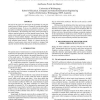Free Online Productivity Tools
i2Speak
i2Symbol
i2OCR
iTex2Img
iWeb2Print
iWeb2Shot
i2Type
iPdf2Split
iPdf2Merge
i2Bopomofo
i2Arabic
i2Style
i2Image
i2PDF
iLatex2Rtf
Sci2ools
ICAD
2004
2004
Control and Measurement of Apparent Sound Source Width and its Applications to Sonification and Virtual Auditory Displays
The aim of this paper is to investigate the possibility of using the spatial extent of sound sources as a mean of carrying information in sonification designs. To do so, we studied the accuracy of the perception of artificially produced sound source extent in a 3D audio environment. We found that the source extent perceived by subjects matched relatively well the intended source extent. Thus source extent could be used as a tool to represent areas, sizes and regions in virtual auditory displays. This paper also reviews the technologies involved in the reproduction and measurement of spatially extended sound sources. Finally, it is shown that the perception of sound source extent can be sensitive to temporal and spectral variations thereby adding extra sonification parameters.
| Added | 31 Oct 2010 |
| Updated | 31 Oct 2010 |
| Type | Conference |
| Year | 2004 |
| Where | ICAD |
| Authors | Guillaume Potard, Ian S. Burnett |
Comments (0)

